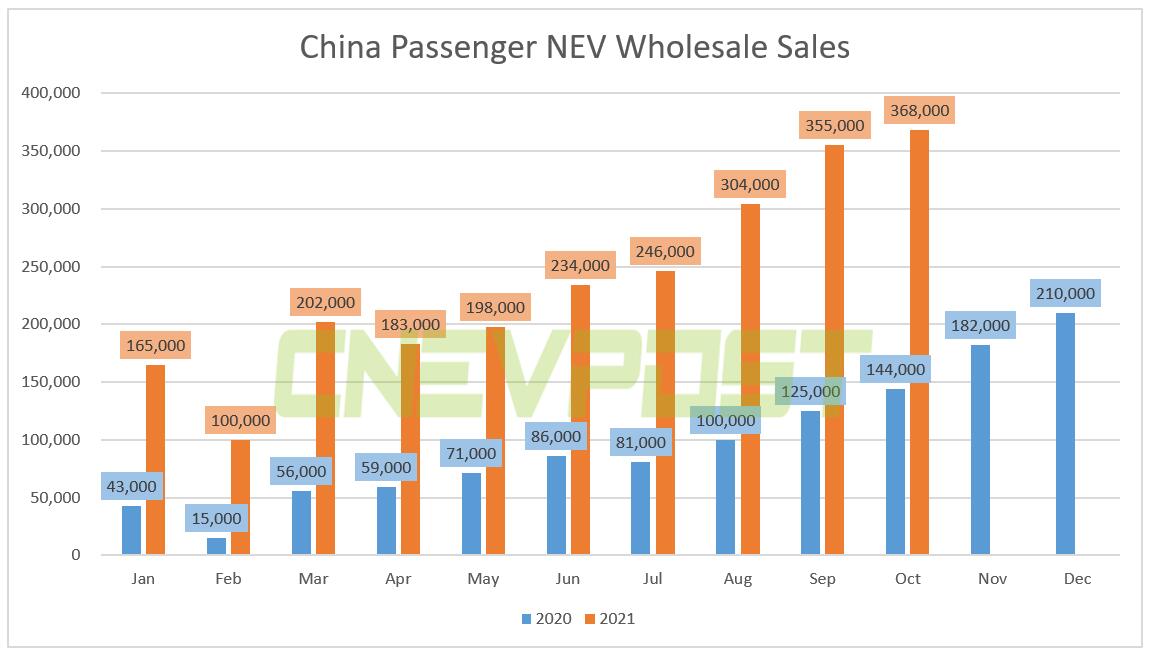Wholesale sales of passenger NEVs in China from January to October were 2,381,000 units, up 204.3 percent year-on-year.
(Graphic by CnEVPost)
China's wholesale sales of new energy passenger vehicles (passenger NEVs) were 368,000 in October, up 148.1 percent year-on-year and up 6.3 percent from September, according to data released today by the China Passenger Car Association (CPCA).
This includes 303,000 BEVs (battery electric vehicles) and 65,000 PHEVs (plug-in hybrid vehicles), accounting for 82.3 percent and 17.7 percent respectively.
Wholesale sales of passenger NEVs in China from January to October were 2,381,000 units, up 204.3 percent year-on-year, the data showed.
Retail sales of passenger NEVs in China reached 321,000 units in October, up 141.1 percent year-on-year and down 3.9 percent from September.
From January to October, China's retail sales of NEVs reached 2.139 million units, up 191.9 percent year-on-year.
Wholesale penetration reached 18.6 percent
The penetration rate of new energy vehicles in wholesale sales in October was 18.6 percent. In the January-October period, the figure was 14.3 percent, a significant increase from the 2020 penetration rate of 5.8 percent.
In October, the penetration rate of NEVs was 30 percent among local brands and 25 percent for luxury vehicles, compared to only 2.7 percent for mainstream joint venture brands.
Wholesale sales of A00-class EVs in October were 94,000, accounting for 31 percent of pure EV sales.
Wholesale sales of A0-class EVs were 51,000, accounting for 17 percent of pure EV sales.
The share of Class A EVs was 25 percent and the share of Class B EVs was 26 percent.
Retail penetration was 18.8 percent
The penetration of NEVs in China was 18.8 percent of retail sales in October, compared to 13 percent in January-October, up from 5.8 percent in 2020.
In October, penetration of NEVs was 36 percent among local brands, 12 percent among luxury vehicles, and only 3.4 percent among mainstream joint venture brands.
Tesla China leads export growth
China's new energy vehicle exports showed explosive growth in October, with Tesla China exporting 40,666 units, the CPCA said.
SAIC Passenger Vehicle exported 6,659 NEVs, BYD 1,026 and FAW Hongqi 424.
BYD stays in first position
BYD's wholesale sales of 80,373 passenger NEVs in October were higher than Tesla's 54,391, and it remains the top wholesale seller of passenger NEVs in China.
SAIC-GM-Wuling's wholesale sales of passenger NEVs in October were 42,133, SAIC Passenger Cars 24,085, GAC Aion 12,064 and Xpeng 10,138, the CPCA said.
BYD PHEV sales were 38,641 units in October, up 17 percent from September, driving the growth of affordable plug-in hybrid models as a new highlight, the CPCA said.
VW's joint ventures in China sold 16,318 NEVs at retail in October, accounting for 72 percent of the mainstream joint venture's share.
BMW's retail sales of NEVs in October were 4,283 units, the CPCA said.
Darkest moment of auto chip supply has passed
The darkest moment for automotive chip supply has passed in the third quarter, the CPCA said.
But the CPCA also noted that chip supply improved by only 10 percent in October compared with September, below their previous expectation of 20 percent, meaning that the bottleneck of opaque supply remains.
There were 22 working days in November, flat relative to last November and five more than in October this year, favoring the growth of production and sales of car companies, the CPCA said.

